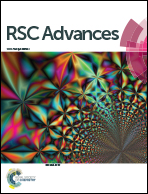Biocompatible electrospinning poly(vinyl alcohol) nanofibres embedded with graphene-based derivatives with enhanced conductivity, mechanical strength and thermal stability†
Abstract
Glycine-modified graphene oxide (GMGO) and its derivative, nanogold-deposited graphene oxide (AuGO), were prepared and then embedded into the matrix of poly(vinyl alcohol) (PVA) nanofibres by electrospinning. The scanning electron microscopy images showed that the morphologies of the nanofibres were improved by the incorporation of GMGO at a low loading content (e.g., 0.1–0.5 wt%) compared with pure electrospun PVA. The two-dimensional, high-aspect ratio GMGO sheets were folded into the nanofibres with a diameter smaller than 150 nm; the microstructures were evaluated using high-resolution transmission electron microscopy. Performing X-ray diffraction analysis revealed that the GMGO-incorporated nanofibres exhibited increased crystallinity. Substantially improved properties, particularly conductivity, mechanical strength, and thermal stability, of PVA electrospun nanofibres embedded with GMGO and AuGO were demonstrated. Analysing PVA composite fibre mats using an electrochemical impedance spectrometer revealed that embedding with GMGO decreased impedance, and that embedding with AuGO decreased it even further. The storage modulus increased by 50.5% and the thermal decomposition temperature increased by approximately 20 °C in the 0.5 wt% GMGO/PVA electrospun nanofibre mats compared with pure PVA nanofibres. Cellular toxicity tests of these electrospun nanofibres showed almost no cytotoxicity to L929 cells.


 Please wait while we load your content...
Please wait while we load your content...